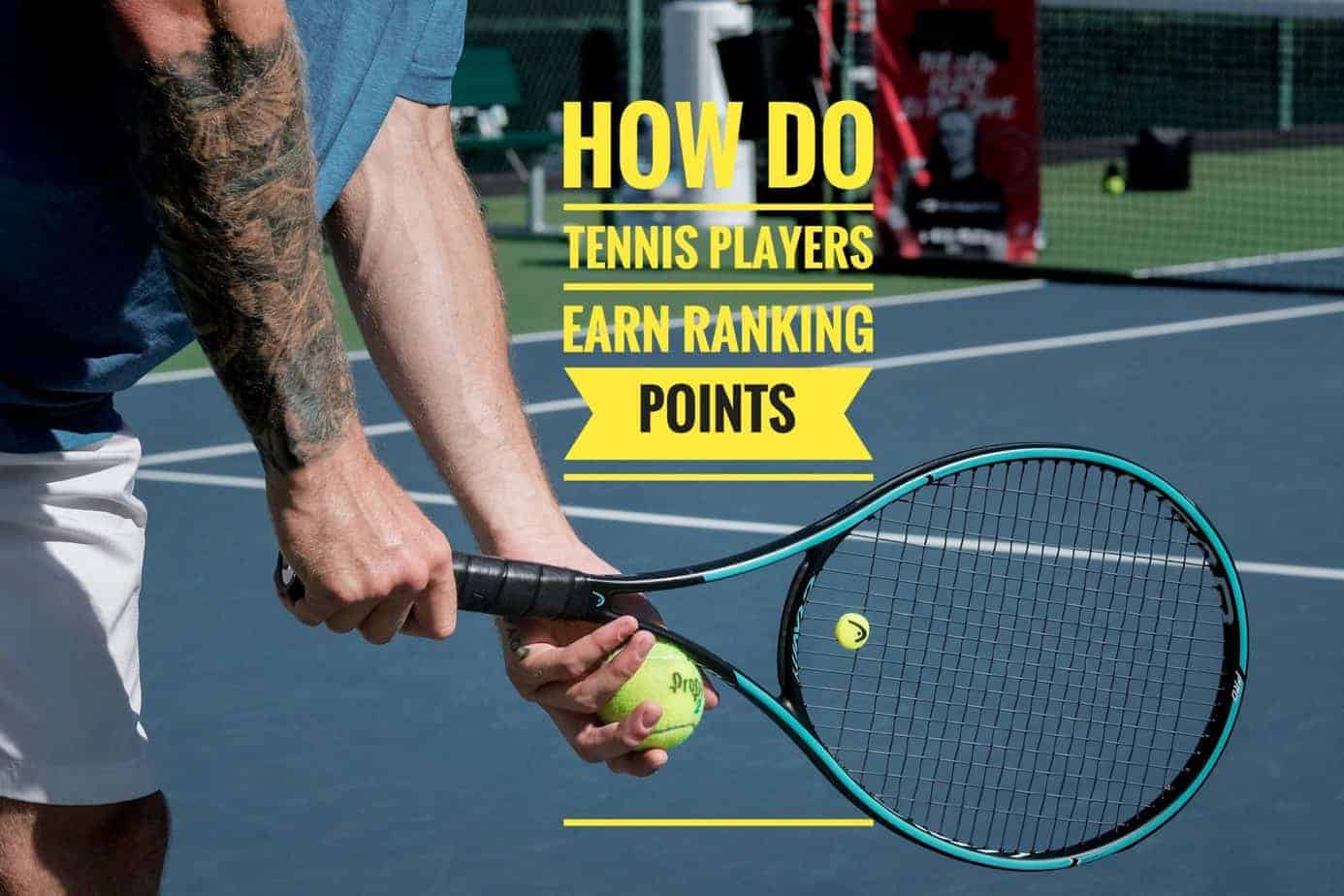When you are a professional tennis player, you often get asked “how do you become a professional tennis player?”. Because tennis is an individual sport, players do not get hired by a team or club (like the NBA, NFL, NHL, Soccer/Football Clubs, etc) so it can be quite difficult to understand the path players need to take in order to reach the top of the rankings.
Tennis rankings work based on a points system that adds up players’ 18 best results in the previous 52 weeks. In order to earn ranking points, tennis players must participate in events hosted by the International Tennis Federation (ITF), the ATP, and the WTA. The number of points earned by the player depends on the round the player loses.
The ITF hosts the Grand Slams and the ITF World Tour Circuit for both men and women. The ATP is in charge of the men’s ATP Tour and Challenger Tour and the WTA takes the lead on the women’s side, putting together the WTA Premier Mandatory, WTA Premier 5, WTA Premier, WTA International and WTA 125K events. Each one of these events has a different point distribution system.
ATP Ranking (Men’s Tour)
The ATP rankings list is the gold standard when it comes to men’s tennis. “The ATP is the governing body of the men’s professional tennis circuits – the ATP Tour and the ATP Challenger Tour. The ATP determines the rules for ATP tournaments and determines the points allocation for all men’s professional events” (ITF World Tennis Tour).
A professional tennis player’s ability to enter tournaments is determined by their position in the rankings. The higher a player’s ranking is (closer to #1), the better. If a player is ranked #70 in the world, wins a tournament, and moves to #40, that player is considered to have moved up in the rankings.
A player’s ranking is determined by their performance in Grand Slams, ATP Tour and Challenger Tournaments, 25K ITF tournaments, and 15K ITF Tournaments. The player’s ranking is based on their best 16 results during a calendar year. The points for a tournament will count towards a player’s ranking for a total of 52 weeks following the result.The ATP Points allocation table is as follows:
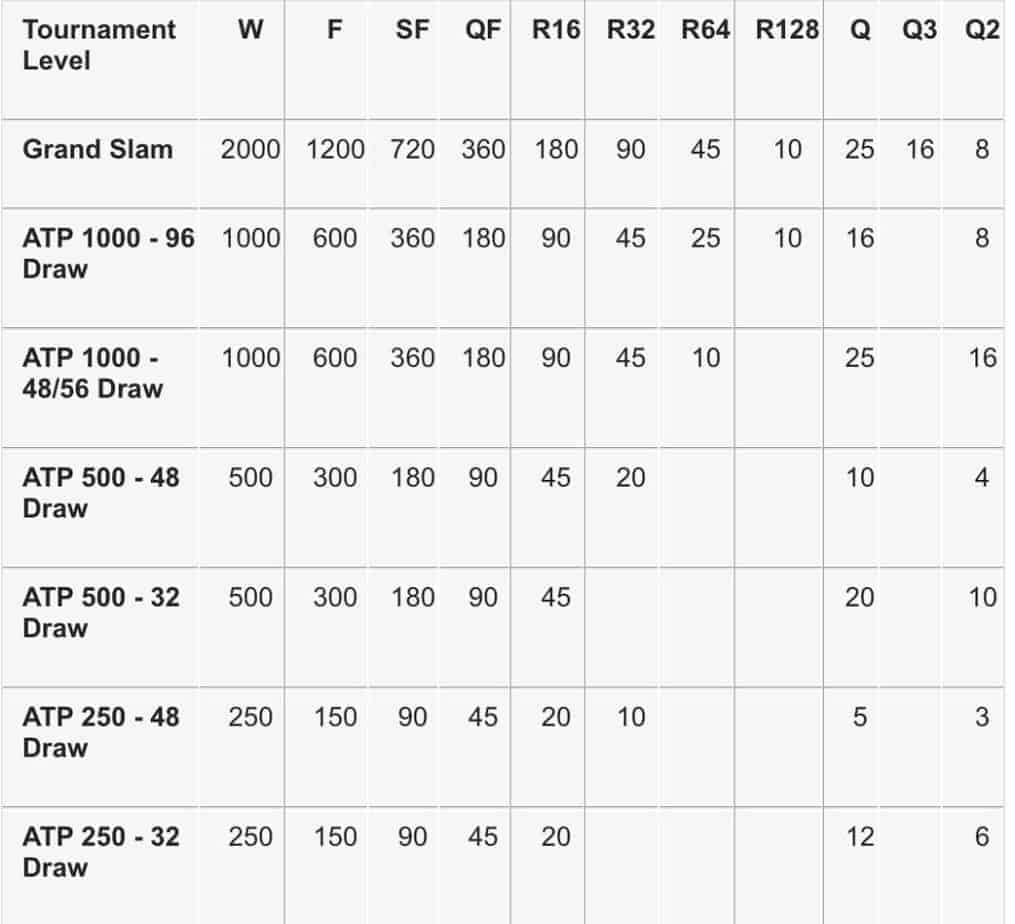
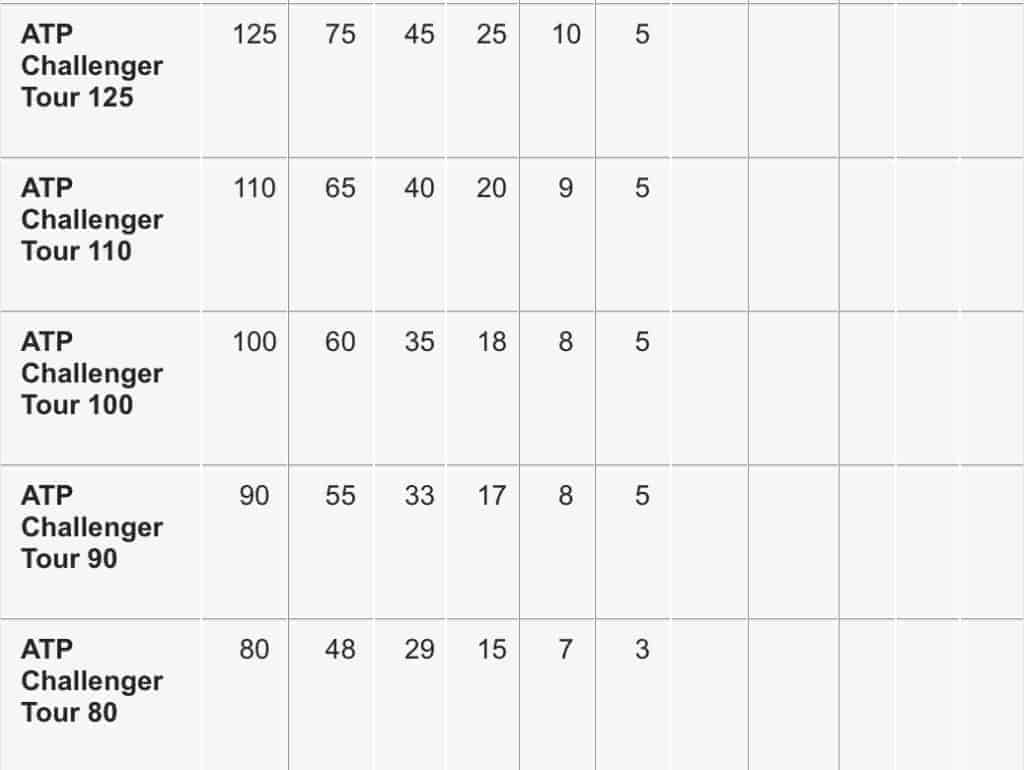
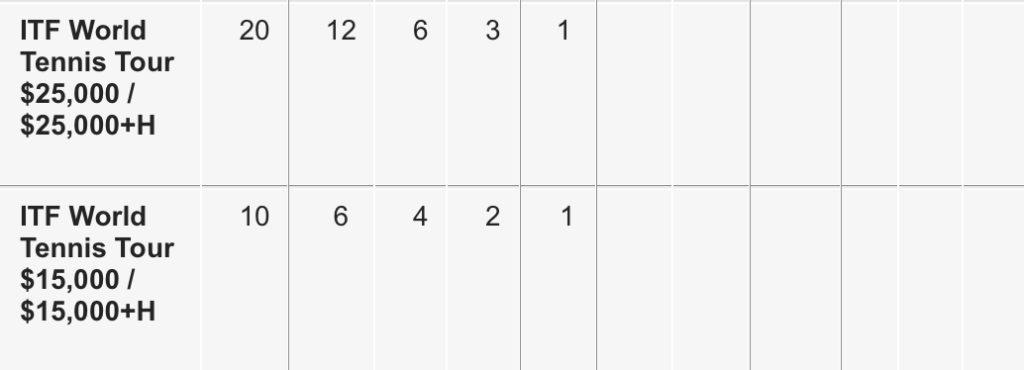
ITF $15,000 and $25,000 (Men)
The first step on the journey of becoming a professional tennis player is to play ITF 15Ks and 25Ks, which are called “futures events.” Futures are where players can earn their first ATP points and get their names on the rankings.
Futures are small events with a total purse of either 15K or 25K distributed among all the players, which includes both singles and doubles. In order to enter these events, players need an IPIN account (a service by ITF), which costs $65 dollars a year. Anyone can have an IPIN account, even without ATP points, and it is on this platform where players sign up for tournaments.
The first (of many) challenging part of playing professionally is being able to play futures events without having ATP points.
When players sign up for futures, the acceptance list is based on the ATP Ranking. There are 20 main draw spots and 48 qualifying spots. If players do not have ATP points, they will often find themselves deep on the alternates page on the acceptance list.
Alternates are the players waiting to get into qualifying. In futures, the players in the qualifying and alternate lists need to sign in to the tournament on-site the day before the qualifying starts.
The problem when players are starting to play futures (and have no ranking) is that there are often many players in front of them on the list, which can be deflating. It is hard to justify traveling to a tournament without knowing for a fact if that player will be able to compete.
That is not to say the qualifying draw will always fill up and you won’t be able to play. In fact, most lower-level tournaments do end up having multiple spots not filled in the qualifying after sign-in. Regardless, starting your professional career can feel overwhelming from the get-go. Some people can rely on wild cards but that is a luxury most players do not have. In any case, here is the points break-down for futures:

Earning that first ATP point is super important. Not only is it a great personal achievement, but it means a player will often be able to compete in any futures qualifying draw. While not many people bat an eye at futures events, they are a major character-building time in a player’s career.
The majority of the players are not able to level up to challengers, therefore most pro careers die here. Now let’s move on to the next level, the ATP Challenger Tour.
ATP Challenger Tour:
After you earn enough points at playing futures, you can graduate to the ATP Challenger Tour. The Challengers are the lowest level tournaments hosted by the ATP. There are 5 tiers of challengers: ATP Challenger Tour 80, 90, 100, 110 and 125. Here is the points breakdown:

As you can see, there is a huge jump in points awarded per round won from futures to challengers. That translates into much tougher competition. Players whose rankings are high enough to be directly accepted will most often compete at a challenger because there is more money and points to be earned.
Cutoffs have changed a bit this year because the draw size at Challenger events increased from 32 to 48 players. Regardless, the cutoff will largely depend on the availability of other tournaments at any given week. Weeks that only have one or two challengers will have cutoffs in the three hundreds, where weeks where there are 4 plus challengers will see the cutoffs dropping to the five, six hundreds.
The challenger level is where we see a lot of the current stars break through. It is where the great get separated from the good. If you ever have the chance to go watch a challenger, do it. Entrance will most likely be free and you will watch high quality tennis all around. Most challenger events include one, if not a couple of current top 100 players.
ATP Tour Events
Aside from Grand Slams, the ATP Tour events are the most well known tournaments. As a player, the ATP Tour is where you want to be. The tournaments are bigger, there is more money and points involved and the atmosphere is awesome. The ATP Tour is the NBA of the tennis world. To consistently play ATP Tour events, a player will have to be ranked inside the top 100. There are three tiers of ATP tour events: ATP Tour 250, ATP Tour 500 and ATP Tour Masters 1000.
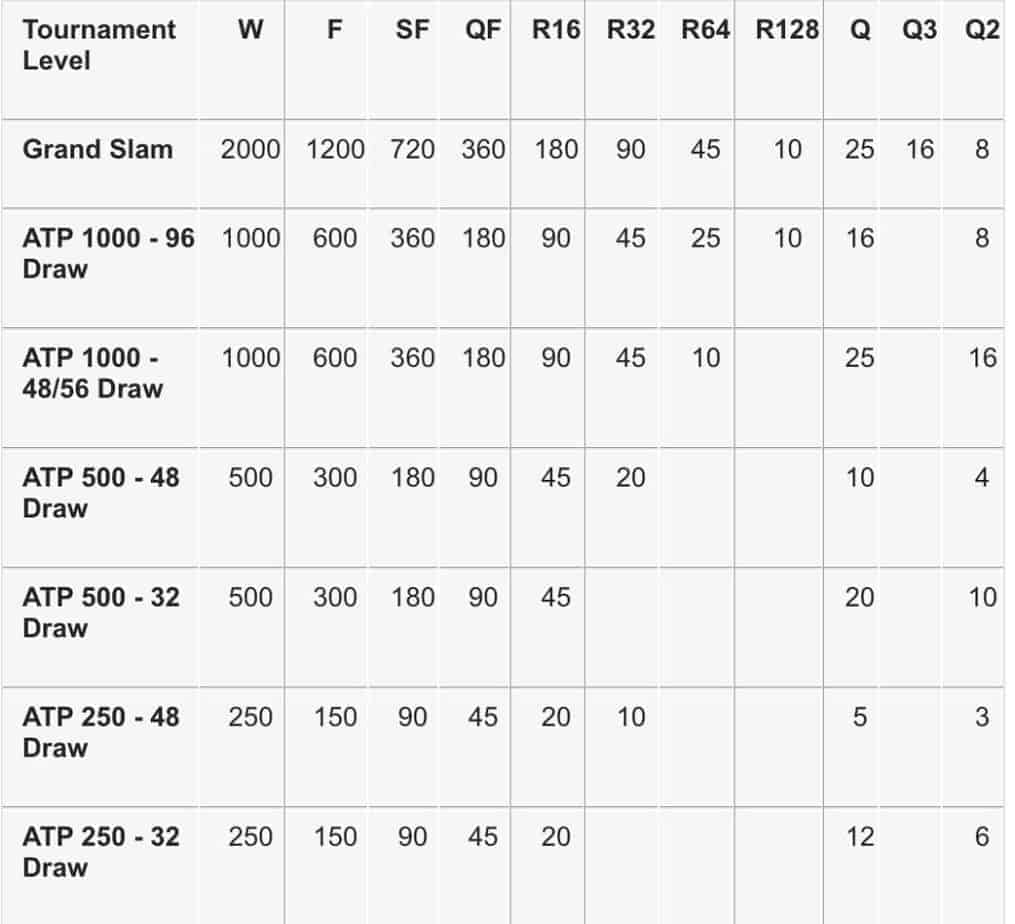
Again, you can see the point distribution drastically increases from the Challenger Tour to the ATP Tour. Players competing on the ATP Tour are the best of the best, and it is every tennis player’s dream to be able to compete on the ATP Tour throughout their careers. The only events that are bigger are the Grand Slams.
Grand Slams
The Grand Slams are the holy grail of tennis. They are the most prestigious events of the year and this is where the most points are awarded. There are four grand slams: Australian Open, Roland Garros (French Open), Wimbledon and the US Open. Here is the points breakdown:

As you should notice, there are massive amounts of points that can be gained at grand slam events. For a player to become number one, he/she will most likely have to win a Grand Slam. If not, the players will have to be incredibly consistent outside of Grand slams. Very few players have achieved that.
WTA Tour (Women’s)
The WTA journey is, for the most part, similar to the ATP. The Women’s Tennis Association is the governing body of the women’s professional tennis circuits. It determines the points allocation for all events. Here is the WTA Points Table.
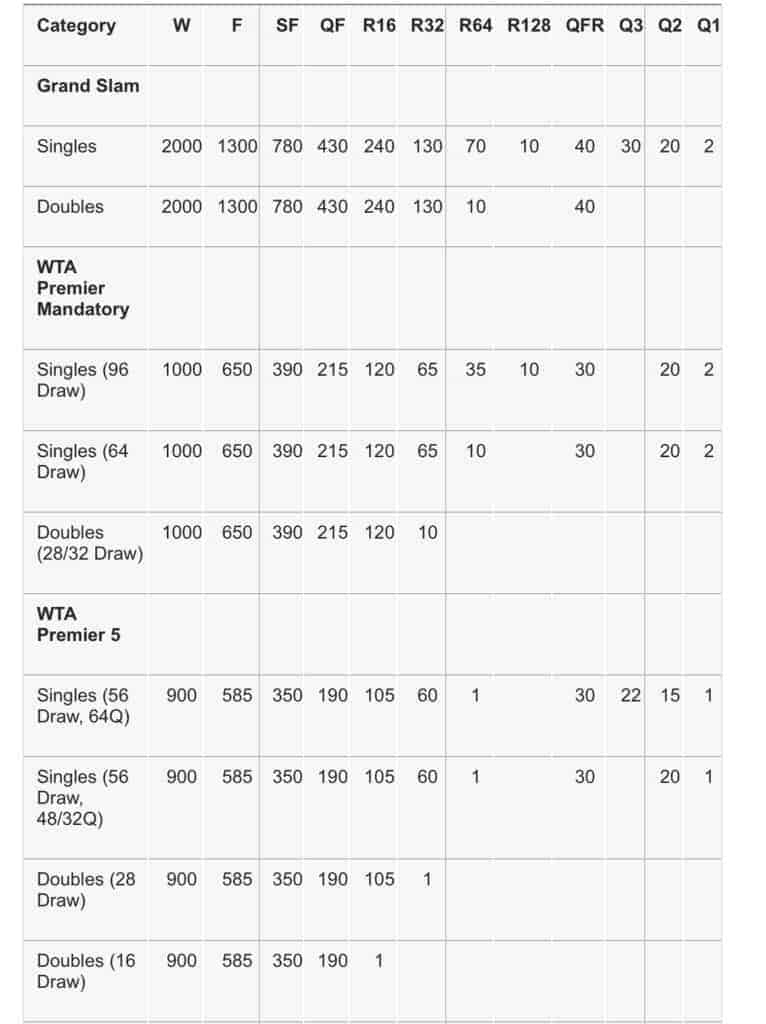


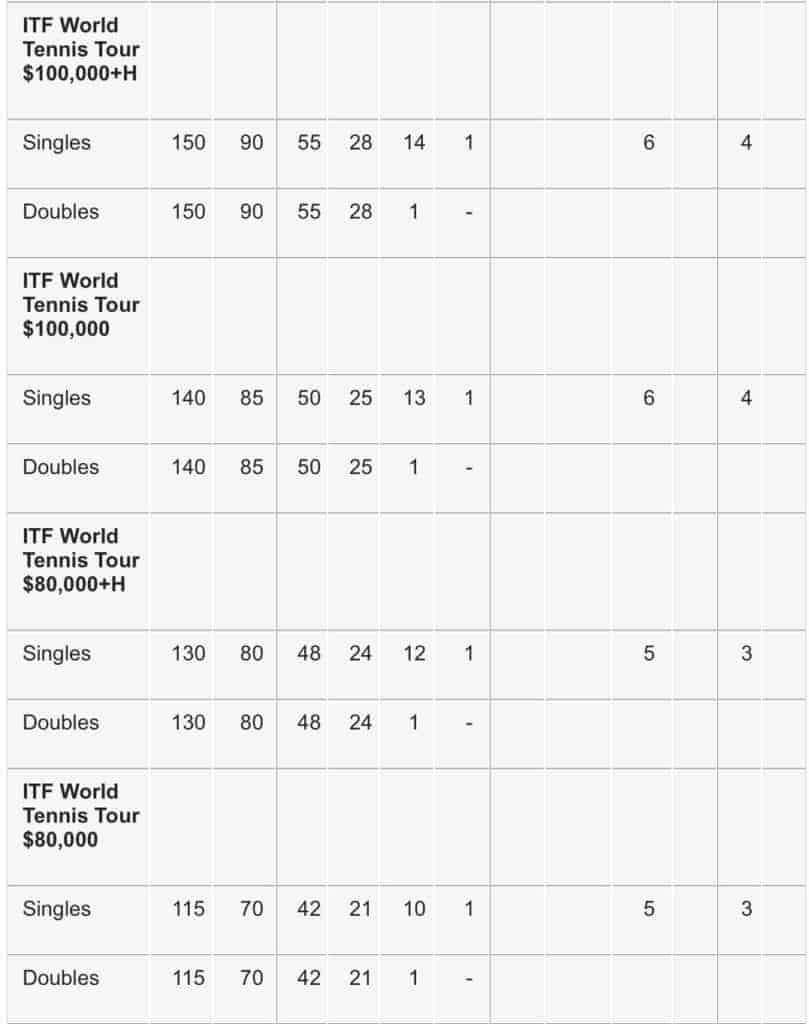

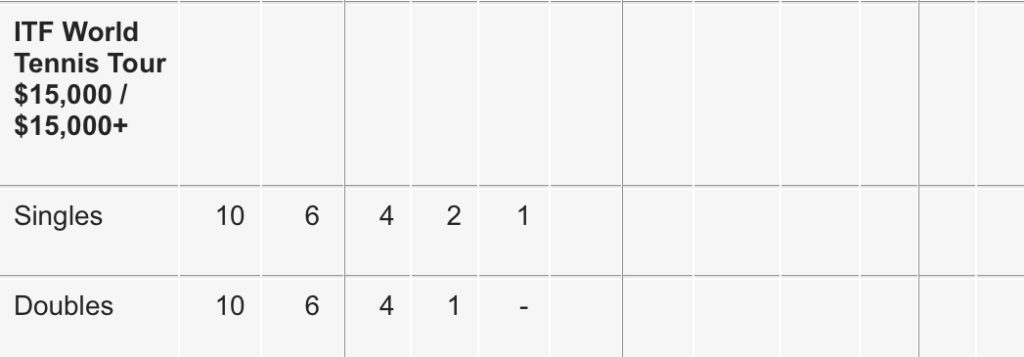
“A player’s ranking for singles is based off their best 16 tournaments and best 11 tournaments for doubles. To have a WTA ranking, players must have WTA ranking points from 3 tournaments or a total of 10 WTA ranking points” – ITF World Tour Points website.
As you can see, there are a few differences in the point structure between the ATP and the WTA. On the women’s side, you need to earn points in three different events in order to be on the WTA rankings, where on the men’s side as long as you win one main draw future’s match, you will automatically be in the rankings.
How Many Points Players Need to Move Up Level
Now that you know how players earn ranking points, let’s take a look at how many points player’s need to earn in order to move up the rankings.
WTA
| Ranking | Points Needed |
| 1000 | 12 |
| 750 | 28 |
| 500 | 76 |
| 300 | 186 |
| 200 | 297 |
| 100 | 661 |
| 75 | 805 |
| 50 | 1115 |
| 20 | 2175 |
| 10 | 3935 |
ATP
Ranking | Points Needed |
| 1000 | 9 |
| 750 | 23 |
| 500 | 58 |
| 300 | 136 |
| 200 | 257 |
| 100 | 576 |
| 75 | 743 |
| 50 | 1017 |
| 20 | 1747 |
| 10 | 2530 |
As you can see, the higher a player’s ranking is, the more points you need earn per tournament in order to continue the upwards trajectory in the rankings. During the future’s stage, it is easier to make big jumps up the rankings. As you move higher, the more difficult it is to do so.
Consistency is key and at the end of the day, there is no magic recipe; the more matches you win the higher your ranking will be. Outsiders usually do not understand how long the journey to top 100 is. It is quite literally a marathon and the majority of players won’t make it through the finish line. Most of the players who reach the top 100 do so after years on tour.

